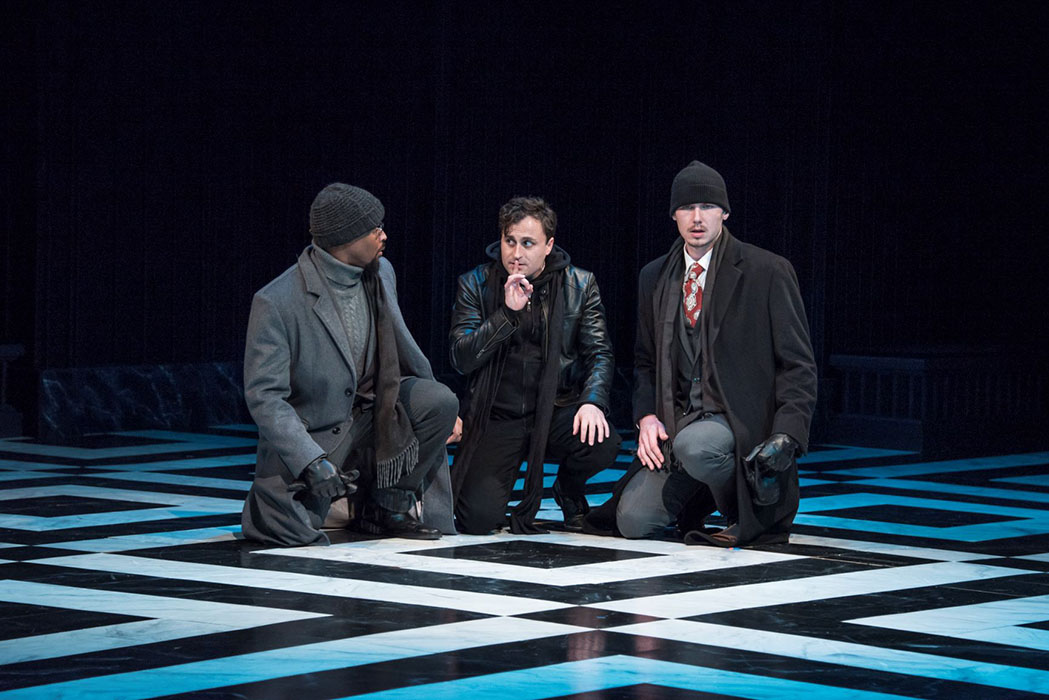I
t has been more than 80 years since Orson Welles and the Mercury Theatre changed a lot of theatrical thinking with their production of Shakespeare’s Julius Caesar, a staging that used a contemporary milieu and dress to draw comparisons to the then-current insidious Fascism that was overrunning Europe. The notoriety of that production opened the door for those producers and directors wanting the dramatic impact of Shakespeare’s captivating narratives and language, but transferred to more modern settings and socio-political contexts that had meaning for contemporary audiences. While Elizabethan purists will generally argue for historical accuracy, Shakespeare’s own explorations of the universal human condition are the very things that render his dramas so adaptable and timely.
In the new Clarence Brown Theatre production of Hamlet in the Carousel Theatre, director John Sipes has taken the play’s psychological underpinnings of grief, family betrayal, and revenge and moved them into a mostly indeterminate earlier-20th Century time frame via abstractions in setting and costumes. He has also made substantial cuts to the script for time and staging, turning what can be a four-hour Hamlet evening into one of two hours and forty-five minutes—imminently doable in the intimate confines of the Carousel with minimal scenery. For those familiar with the play: the subplot of the Fortinbras-led invasion of Denmark by Norway has been removed as has another thorny issue confronting most productions. While the plot-motivating existence of the Ghost as the spirit of Hamlet’s deceased father is important and essential, visualizing it properly takes resources that don’t necessarily advance the plot. In what seems to be more a staging expediency than a theatrical metaphor, the Ghost is never seen in this production and is heard only in voiceover by Hamlet and the audience. On the other hand, this does allow the ambiguity of the ghost’s reality to be yet another philosophical question for the audience. Ultimately, though, one must weigh whether this treatment of the Ghost is as effective as it should be.
Whether condensed or not, the character of Hamlet is one of the most complex in all of western drama, requiring an actor able to sift deftly through the layers of grief brought on by a father’s death and a mother’s apparent betrayal—and still, nimbly navigate the intricate majesty of Shakespearean language. Just such a Hamlet is Charles Pasternak, seen previously in CBT’s Peter and the Starcatcher and as the hilarious Marplot in The Busy Body. Mr. Pasternak’s complex and volatile performance, one that is equal parts disquieting consternation and revelation, is reason enough to catch this production of Hamlet. Interestingly, director Sipes and costume designer Bill Black have put Hamlet in black and white attire—white shirt and black trousers—tipping off the production’s palette and Hamlet’s conflict between morality and revenge.

Photo Brynn Yeager
There is a hint of moral ambiguity to Michael Elich’s marvelous portrayal of Claudius, Hamlet’s uncle who quickly marries Hamlet’s mother after murdering his brother to become king. Elich handles the brief moments of his humanity with softness, allowing his Claudius to believe he has won at the deception. However, as Hamlet baits him into a reaction by having the traveling players construct a play suggesting the murder he committed, he reveals that he is a gloriously brittle tyrant—and is thus clothed in colors ranging from dark to all black.
Abbey Siegworth is the regal, but sadly ambivalent Gertrude, Hamlet’s mother, who hears, but never listens or understands the plight of her son, or recognize the inherent evil in her new husband. As a result, she appears in off-white clothing, as does poor doomed Ophelia (Brittany Marie Pirozzoli) who is in love with Hamlet, but unable to understand the method or madness in his harshness. Doomed by her fragility that Hamlet is forced to exploit, Pirozzoli gave her own mad scene a heart-wrenching poignance.
Ophelia’s father is the tedious and irksome Polonius, taken here by the appropriately all-gray David Brian Alley in another of his many marvelous serio-comic turns. Polonius’ instruction to his son Laertes (Collin Andrews) as he goes off to France is one of the classics of Shakespeare’s quotables—and Alley made it memorable.
Unfortunately, the script reduction has removed some importance from the secondary characters, notably Horatio, Marcellus, and Bernardo. In the case of Jade Arnold’s otherwise well-played Horatio, this lessens an important philosophical background connection. Nevertheless Peter Mayer Klepchick and Michael Najman were also admirable as Marcellus and Bernardo, respectively. Roderick Peeples did a marvelous turn as the Player King.
Needless to say, with Sipes, a fight specialist, directing the play, the final sword fight between Laertes and Hamlet was masterful and brilliantly accomplished. Michael Ganio’s set in the Carousel defines the space in an almost-in-the-round thrust arrangement that has a black and white patterned floor and an interesting entrance scheme of screen-wire doors. I just know there is a visual metaphor lurking in there somewhere. Kenton Yeager’s lighting modulated the black and white look with overhead color to represent moments of dramatic crisis. Not to be overlooked—or under-heard—is Joe Payne’s superb expressionistic music/soundtrack.
The beauty of this production is that it asks more questions than it answers—what is the nature of madness? Of death? Of existence? “To be, or not to be, —that is the question…”






I am anxious to see it.
Sir John Gielgud tried a similar approach in his legendary Broadway production which opened April 9, 1964. It, of course, starred Richard Burton (fresh from his marriage to Elizabeth Taylor) and Knoxville’s own John Cullen as Laertes, along with Hume Cronyn and Alfred Drake. Sir John himself provided the voice of the ghost, which was only seen as a projected shadow spanning the width of the stage. It was performed in contemporary dress.
Contractually destroyed, Burton kept one copy of the film and sent one to the British Film Institute, from which the DVD was finally released in 1995.